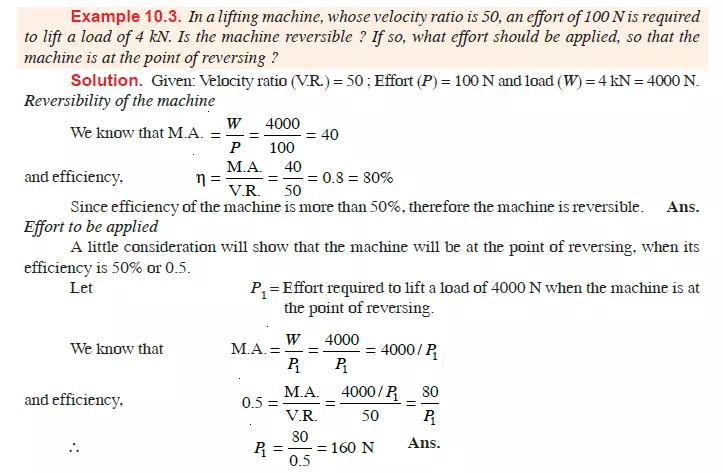Principles of Lifting Machines
INTRODUCTION
In olden times, thousands of slaves had to be arranged, whenever a heavy load had to be lifted or dragged. Even today, in the absence of a suitable device, many people have to be arranged to lift a motor car so that its tyres can be changed. In order to overcome such difficulties, a few simple machines were invented, which could save the man power i.e., a single
man can do the same work as many could do, though at a lesser speed. Before entering into the details of simple machines and their working, following terms should be clearly understood at this stage :
SIMPLE MACHINE
In a broad sense, a simple machine may be defined as a device, which enables us to do some useful work at some point or to overcome some resistance, when an effort or force is applied to it, at some other convenient point.
COMPOUND MACHINE
A compound machine may be defined as a device, consisting of a number of simple machines, bwhich enables us to do some useful work at a faster speed or with a much less effort as compared to a simple machine.
LIFTING MACHINE
It is a device, which enables us to lift a heavy load (W) by applying a comparatively smaller effort (P).
MECHANICAL ADVANTAGE
The mechanical advantage (briefly written as M.A.) is the ratio of weight lifted (W) to the effort applied (P) and is always expressed in pure number. Mathematically, mechanical advantage,

INPUT OF A MACHINE
The input of a machine is the work done on the machine. In a lifting machine, it is measured by the product of effort and the distance through which it has moved.
OUTPUT OF A MACHINE
The output of a machine is the actual work done by the machine. In a lifting machine, it is measured by the product of the weight lifted and the distance through which it has been lifted.
EFFICIENCY OF A MACHINE
It is the ratio of output to the input of a machine and is generally expressed as a percentage.
Mathematically, efficiency,

IDEAL MACHINE
If the efficiency of a machine is 100% i.e., if the output is equal to the input, the machine is called as a perfect or an ideal machine.
VELOCITY RATIO
The velocity ratio (briefly written as V.R.) is the ratio of distance moved by the effort (y) to the distance moved by the load (x) and is always expressed in pure number. Mathematically, velocity
ratio,

RELATION BETWEEN EFFICIENCY, MECHANICAL ADVANTAGE AND VELOCITY RATIO OF A LIFTING MACHINE
It is an important relation of a lifting machine, which throws light on its mechanism. Now consider a lifting machine, whose efficiency is required to be found out.


REVERSIBILITY OF A MACHINE
Sometimes, a machine is also capable of doing some work in the reversed direction, after the effort is removed. Such a machine is called a reversible machine and its action is known as
reversibility of the machine.
CONDITION FOR THE REVERSIBILITY OF A MACHINE
Consider a reversible machine, whose condition for the reversibility is required to be found out.
Let W = Load lifted by the machine,
P = Effort required to lift the load,
y = Distance moved by the effort, and
x = Distance moved by the load.

A little consideration will show that in a reversible machine, the *output of the machine should
be more than the machine friction, when the effort (P) is zero. i.e.,


SELF-LOCKING MACHINE
Sometimes, a machine is not capable of doing any work in the reversed direction, after the effort is removed. Such a machine is called a non-reversible or self-locking machine. A little
consideration will show, that the condition for a machine to be non-reversible or self-locking is that its efficiency should not be more than 50%.

